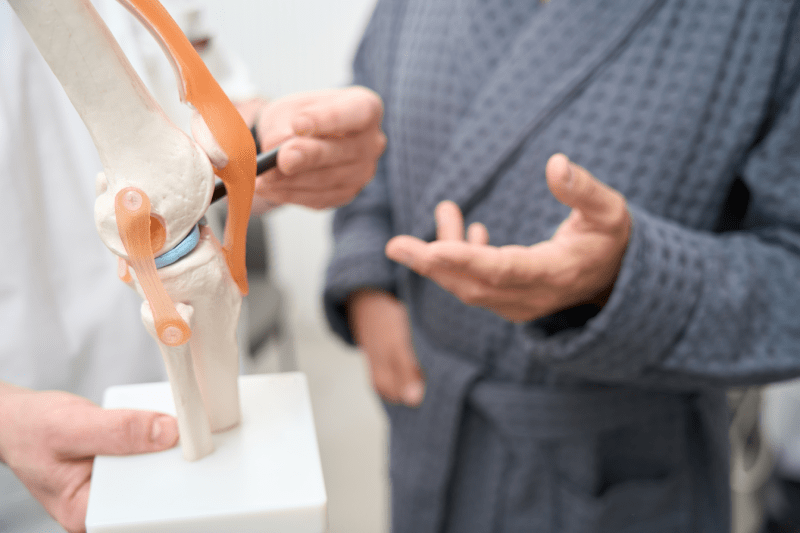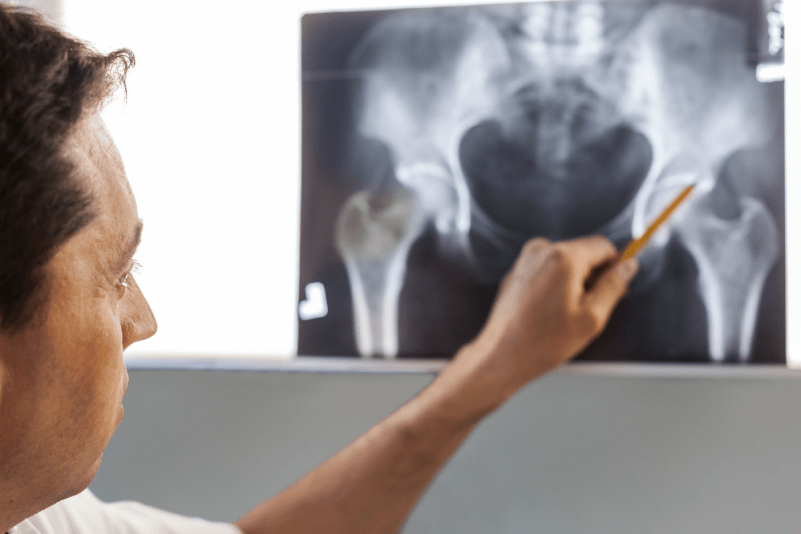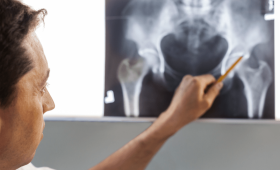What is Hip Replacement Surgery?
Hip replacement surgery is a surgical procedure performed to repair damage to the hip joint caused by advanced wear and tear, osteoarthritis, or trauma. In this procedure, the damaged joint cartilage and bone tissues are removed and replaced with an artificial joint (prosthesis). The prosthesis consists of two main parts called the ball and socket. The main purpose of this surgery is to relieve the patient’s unbearable hip pain, increase their mobility, and significantly improve their overall quality of life. The surgery can be performed using either minimally invasive or traditional surgical methods.
What is Minimally Invasive Hip Replacement Surgery?
Minimally invasive hip replacement surgery is a modern technique in which the prosthesis is placed through a smaller surgical incision, causing minimal damage to the muscles and surrounding tissues. In this method, the surgeon reaches the joint by going between the muscles rather than cutting them. This approach minimizes tissue damage and accelerates the post-operative recovery process. Since minimally invasive methods generally require a smaller surgical field compared to traditional surgery, they may require special tools and more experience.
What is Traditional Hip Replacement Surgery?
Traditional hip replacement surgery is the standard surgical method where a larger surgical incision is made to access the hip joint, and some muscles are cut or separated to expand the surgical field. This method has been successfully used for many years and is the most common hip replacement technique worldwide. During the operation, the surgeon places the prosthesis with a wider view of the joint and bone structures. When performed by experienced surgeons, it yields very safe and effective results.
What is the Main Difference Between Minimally Invasive and Traditional Methods?
The main difference between the minimally invasive and traditional methods is the size of the surgical incision and the degree of damage to the muscles. In the minimally invasive method, the incision is smaller and the muscles are preserved, whereas in the traditional method, a larger incision is made and the muscles are cut or separated to access the joint. This difference directly affects the level of post-operative pain, blood loss, and the patient’s recovery speed. Minimally invasive surgery offers a faster recovery process than the traditional method.
What Are the Advantages of the Minimally Invasive Method?
Among the greatest advantages of minimally invasive hip replacement surgery are less blood loss and less tissue damage due to smaller incisions. This leads to less pain after surgery and allows the patient to regain mobility more quickly. Additionally, smaller incisions provide better aesthetic results and can shorten the hospital stay. Preserving the muscles can increase hip stability and speed up recovery after surgery.
What Are the Advantages of the Traditional Method?
The greatest advantage of traditional hip replacement surgery is that it is a method that has been used for many years with proven results. The surgeon can see the joint and bone structures more easily with a larger surgical field, which can provide more accurate prosthesis placement, especially in complex cases or when there is advanced joint deformation. In the hands of an experienced surgeon, this method yields very successful and reliable results.
Which Patients Are Suitable for Minimally Invasive Surgery?
Minimally invasive hip replacement surgery is generally suitable for patients who are at an ideal weight, have strong muscle structure, and do not have advanced bone deformities. Young and active patients, in particular, can benefit more from this method due to faster recovery and the possibility of returning to normal life. However, since every patient’s condition is different, the decision on suitability is made based on the surgeon’s detailed evaluation.
What is the Pre-Surgery Preparation Process Like?
Pre-operative preparation is similar for both minimally invasive and traditional methods. The surgeon will request various tests (blood tests, ECG, chest X-ray) to evaluate the patient’s general health. All medications the patient is taking are reviewed, and it is determined when blood-thinning medications, in particular, should be stopped before the surgery. To ensure the surgery is successful and to reduce the risk of infection, the patient may be advised to reach an ideal weight and quit smoking.
How is Post-Surgery Pain Management Handled?
Post-surgery pain management is critical for the patient’s comfort and recovery process. In minimally invasive surgeries, pain is generally milder due to less muscle damage. Patients are given intravenous pain relievers during their hospital stay. Upon discharge, oral medications are prescribed. Pain can be intense in the first few days, but it can be controlled with medication, ice application, and rest.
When Does Physical Therapy Begin and How Long Does It Last?
Physical therapy after hip replacement surgery usually begins the day after the surgery. This process is of vital importance for the success of the surgery. The physical therapy program includes regular exercises to help the patient regain strength and mobility. The program generally lasts for 3 to 6 months, but full functional recovery can take up to a year. Patients who have minimally invasive surgery can start physical therapy earlier.
How Long is the Hospital Stay?
The length of the hospital stay after hip replacement surgery varies depending on the patient’s overall health and the type of surgery. Minimally invasive surgeries can shorten the hospital stay by providing faster recovery. Generally, patients who have minimally invasive surgery can stay in the hospital for 1 to 3 days, while those who have traditional surgery may stay for 3 to 5 days.
What is the Lifespan of the Prosthesis?
The lifespan of modern hip prostheses used today is quite long. A hip prosthesis is generally expected to be used without any problems for 15 to 25 years. The lifespan of the prosthesis can vary depending on the patient’s age, activity level, and the type of prosthesis. It is thought that minimally invasive surgery contributes positively to the lifespan of the prosthesis by preserving the muscles and increasing its surrounding stability.
What Are the Risks of Minimally Invasive Surgery?
Although minimally invasive hip replacement surgery is a safe method, it carries some risks like any surgical procedure. These risks include infection, bleeding, nerve damage, and leg length inequality. Additionally, potential errors in prosthesis placement due to the small surgical field can pose a risk for inexperienced surgeons. Therefore, choosing an experienced surgeon in this field is of great importance.
What Are the Risks of Traditional Surgery?
The risks of traditional hip replacement surgery are similar to those of minimally invasive surgery. Risks such as infection, bleeding, prosthesis loosening, hip dislocation, and blood clots exist. Due to the larger incision, the risk of bleeding and infection may be slightly higher compared to the minimally invasive method. When performed by an experienced surgeon, these risks are minimized, and a safe operation is provided for the patient.
Is the Cost of Minimally Invasive Surgery Different from Traditional Surgery?
Minimally invasive surgery can be more expensive than the traditional method as it may require special tools and more expertise. However, this cost difference can be balanced by indirect benefits such as a shorter hospital stay and a quicker return to work. In Turkey, the prices for both methods vary depending on the hospital, the surgeon, and the materials used.
How Long Does Minimally Invasive Hip Replacement Surgery Take?
The duration of minimally invasive hip replacement surgery varies depending on the patient’s condition and the surgeon’s experience. On average, this surgery is completed in 1 to 2 hours. It is not generally shorter than the traditional method, but the recovery process is faster. The surgeon’s experience is a decisive factor in the duration of the operation.

How Long Does Traditional Hip Replacement Surgery Take?
Traditional hip replacement surgery is usually completed in similar durations to the minimally invasive method, averaging between 60 to 90 minutes. This duration can vary depending on the surgeon’s experience and the condition of the patient’s hip joint. The faster completion of the surgery shortens the time the patient is under anesthesia.
When Can I Start Walking Normally After Surgery?
After minimally invasive hip replacement surgery, patients can begin walking with support, assisted by a physical therapist, the day after the surgery. Due to less muscle damage, patients can get on their feet more quickly, and the need for a walker may be shorter. The process of walking completely unsupported can vary from a few weeks to a few months, depending on the patient’s overall health and the progress of rehabilitation.
When Can I Return to Exercise and Sports?
During the post-operative recovery process, patients can generally return to light exercises (such as walking, swimming) after 3 to 6 months. Patients who have minimally invasive surgery can start these activities earlier because their muscles are less affected. For more strenuous sports (running, tennis, skiing), a doctor’s approval must be obtained, and they should generally be started after 6 months. It is important to avoid high-impact sports to extend the life of the prosthesis.
What Should Be Paid Attention to After Surgery?
After surgery, some rules must be followed to extend the life of the prosthesis and prevent complications. It is important to strictly adhere to the exercise program recommended by the physical therapist, avoid overstraining the hip, and be careful against trauma such as falling from a height. Additionally, regular doctor check-ups are of vital importance to monitor the condition of the prosthesis. Movements that would strain the hip should be avoided in the first few months.
Does Leg Length Inequality Occur?
Leg length inequality after hip replacement surgery is a potential risk in both minimally invasive and traditional surgery. This risk is minimized with correct measurement and planning before and during the surgery. In minimally invasive methods, since the surgeon’s field of view is more limited, the surgeon’s experience is of great importance in managing this risk.
What Does Revision Surgery Mean?
Revision surgery is the procedure of removing a previously implanted hip prosthesis and replacing it with a new one, due to reasons such as the prosthesis reaching the end of its lifespan, loosening, infection, or fracture. It is thought that minimally invasive surgery can reduce the need for revision surgery by providing less tissue damage and more accurate placement, but this requires long-term follow-up.
What Are the Most Important Success Criteria of the Surgery?
The success of hip replacement surgery is not limited to the correct placement of the prosthesis. The most important success criteria are the complete disappearance of the patient’s post-operative pain, increased hip mobility, and the ability to comfortably perform daily life activities. Minimally invasive surgery can help achieve these goals more quickly.
What Are the Types of Minimally Invasive Approaches?
Minimally invasive hip replacement surgeries are generally named according to the location of the incision where the surgeon accesses the hip joint. The most common minimally invasive approaches include the anterior, lateral, and posterolateral approaches. Each approach has its unique advantages and disadvantages, and the surgeon determines the most suitable one for the patient’s condition.
Why is Hip Replacement Surgery Preferred in Turkey?
Turkey is a globally popular destination for hip replacement surgeries. The main reasons for this include hospitals with modern technology, expert and experienced surgeons, and more affordable costs compared to other countries. Additionally, the quality healthcare services and rehabilitation opportunities offered after surgery also play an important role in why patients choose Turkey.
When Can I Start Driving After Surgery?
The time to start driving after surgery depends on whether the operated hip is on the right or left side and the patient’s recovery speed. Generally, you can start driving after you have stopped using support devices and are sure that you can safely press the brake pedal with your leg. This period usually varies from 6 to 8 weeks after the surgery.
How Should Post-Surgery Nutrition Be?
Nutrition is of great importance in supporting the post-operative recovery process. Foods high in protein (chicken, fish, eggs) help with muscle repair. Foods rich in calcium and Vitamin D (dairy products, green leafy vegetables) support bone health. Adequate fluid intake is also vital during the post-operative period. Alcohol and smoking should be avoided.
What is the Importance of Physical Therapy?
Physical therapy is just as important as the surgery itself for the success of hip replacement surgery. Regular exercises strengthen the muscles around the new prosthesis, increase the joint’s mobility, and allow the patient to return to their daily activities more quickly. Strict adherence to the physiotherapy program extends the life of the prosthesis and reduces the risk of complications.
Is Minimally Invasive Surgery Safer?
Both methods are safe when performed by experienced surgeons. Minimally invasive surgery offers advantages such as less blood loss and less tissue damage, potentially reducing some risks. However, the small surgical field can create challenges for inexperienced surgeons. Therefore, the safety of the surgery depends on the surgeon’s experience and the suitability of the chosen method for the patient’s condition.
How Can I Find the Best Surgeon?
To find the best surgeon, you should first research surgeons who specialize in orthopedics and traumatology, especially those with experience in hip surgery. It is useful to read patient reviews and get information about the surgeon’s past success rates and patient satisfaction. A reliable surgeon will patiently answer your questions and inform you in detail about all stages of the surgery. In this field, experience is the most important factor that directly affects success.



